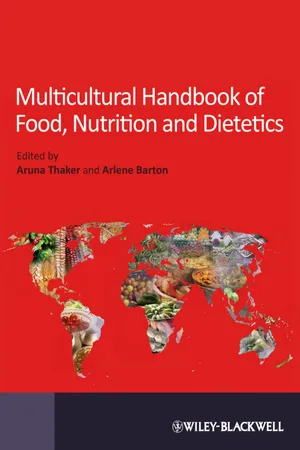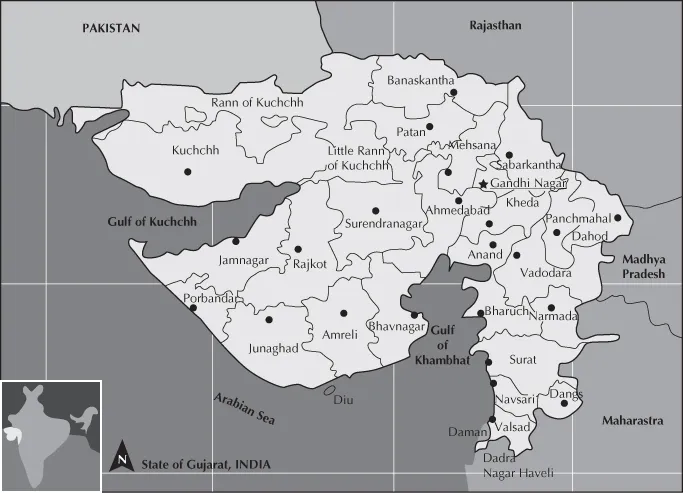
eBook - ePub
Multicultural Handbook of Food, Nutrition and Dietetics
Aruna Thaker, Arlene Barton, Aruna Thaker, Arlene Barton
This is a test
Buch teilen
- English
- ePUB (handyfreundlich)
- Über iOS und Android verfügbar
eBook - ePub
Multicultural Handbook of Food, Nutrition and Dietetics
Aruna Thaker, Arlene Barton, Aruna Thaker, Arlene Barton
Angaben zum Buch
Buchvorschau
Inhaltsverzeichnis
Quellenangaben
Über dieses Buch
Multicultural Handbook of Food, Nutrition and Dietetics is the must have practical resource for dietitians, nutritionists and students working with both well settled but also recently migrated ethnic groups.
Written by a team of authors drawn from the British Dietetic Association's Specialist Multicultural Nutrition Group the book provides in-depth information to equip the reader in the provision of nutrition advice to minority groups. Spanning a broad range of cultural groups the book seeks to consider religious and cultural requirements in relation to traditional diets; research on migration studies and chronic disease states; and nutrition and dietetic treatment in relation to key chronic diseases.
Häufig gestellte Fragen
Wie kann ich mein Abo kündigen?
Gehe einfach zum Kontobereich in den Einstellungen und klicke auf „Abo kündigen“ – ganz einfach. Nachdem du gekündigt hast, bleibt deine Mitgliedschaft für den verbleibenden Abozeitraum, den du bereits bezahlt hast, aktiv. Mehr Informationen hier.
(Wie) Kann ich Bücher herunterladen?
Derzeit stehen all unsere auf Mobilgeräte reagierenden ePub-Bücher zum Download über die App zur Verfügung. Die meisten unserer PDFs stehen ebenfalls zum Download bereit; wir arbeiten daran, auch die übrigen PDFs zum Download anzubieten, bei denen dies aktuell noch nicht möglich ist. Weitere Informationen hier.
Welcher Unterschied besteht bei den Preisen zwischen den Aboplänen?
Mit beiden Aboplänen erhältst du vollen Zugang zur Bibliothek und allen Funktionen von Perlego. Die einzigen Unterschiede bestehen im Preis und dem Abozeitraum: Mit dem Jahresabo sparst du auf 12 Monate gerechnet im Vergleich zum Monatsabo rund 30 %.
Was ist Perlego?
Wir sind ein Online-Abodienst für Lehrbücher, bei dem du für weniger als den Preis eines einzelnen Buches pro Monat Zugang zu einer ganzen Online-Bibliothek erhältst. Mit über 1 Million Büchern zu über 1.000 verschiedenen Themen haben wir bestimmt alles, was du brauchst! Weitere Informationen hier.
Unterstützt Perlego Text-zu-Sprache?
Achte auf das Symbol zum Vorlesen in deinem nächsten Buch, um zu sehen, ob du es dir auch anhören kannst. Bei diesem Tool wird dir Text laut vorgelesen, wobei der Text beim Vorlesen auch grafisch hervorgehoben wird. Du kannst das Vorlesen jederzeit anhalten, beschleunigen und verlangsamen. Weitere Informationen hier.
Ist Multicultural Handbook of Food, Nutrition and Dietetics als Online-PDF/ePub verfügbar?
Ja, du hast Zugang zu Multicultural Handbook of Food, Nutrition and Dietetics von Aruna Thaker, Arlene Barton, Aruna Thaker, Arlene Barton im PDF- und/oder ePub-Format sowie zu anderen beliebten Büchern aus Medicine & Nutrition, Dietics & Bariatrics. Aus unserem Katalog stehen dir über 1 Million Bücher zur Verfügung.
Information
1
South Asian Sub-continent
The cultural groups from Gujarat, Punjab, Pakistan, Bangladesh and Sri Lanka have migrated from the South Asian subcontinent to the United Kingdom from different regions over last 60 years, mostly due to economic and political upheavals, and made the UK their home. As a result of the vast distances between the countries there were many differences in their cultural, traditional beliefs and diets but also many similarities as well. The reasons for these changes are many, but lifestyle changes, especially dietary changes, have had the greatest impact on health. The traditional diets which they were following were much healthier, more in line with what is currently recommended, but inclusions of some of the host country’s unhealthy foods are having detrimental effects. This is now highlighted in scientific research; however, much of this is generic to those of South Asian origin rather than related to specific cultural groups. In this book, for the first time, an attempt has been made to provide detailed information on each of group. There is information on migration, traditional diets and changes in migration, religious influences and on dietary considerations for specific diseases, such as obesity, diabetes and cardiovascular disease.
1.1 Gujarati Diet
1.1.1 Introduction
The South Asian sub-continent comprises India, Pakistan, Bangladesh and Sri Lanka. Four per cent of the total UK population is classified as ‘Asian’ or ‘Asian British’ and this group makes up 50.2% of the UK minority ethnic population (UK Census, 2001).
‘South Asian’ defines many ethnic groups, with distinctive regions of origin, languages, religions and customs, and includes people born in India, Bangladesh, Pakistan or Sri Lanka (Fox, 2004).
Gujarat state is situated on the west coast of India and boasts a 1,600 km-long coastline. The Arabian Sea sweeps the western and south-western frontiers. The state extends from Kutch in the west to Daman in the south, with Pakistan to the north-west and the state of Rajasthan to the north and north-east. To the east is Madhya Pradesh and Maharashtra (Figure 1.1.1). This state celebrated the 50th anniversary of its formation on 1 May 2010.
Figure 1.1.1 Map of Gujarat

Gujarat is one of the prime developing states of India and is known for its vibrancy and colourful profile. Traditionally, the population has engaged in agriculture as their principal occupation. It is the main producer of tobacco, cotton, peanuts (groundnuts) and other major food crops (rice, wheat, sorghum (jowar), millet (bajra), maize, red gram dal (tuvar dal) and whole pulses); crops account for more than half of the total land area. Animal husbandry and dairy farming also play a vital role in the rural economy. Dairy farming – primarily milk production – is run on a cooperative basis and has more than a million members; it is one of the best examples of cooperative enterprise in the developing economy so that Gujarat is now the largest producer of milk in India. ‘Amul’ (Anand Milk Union Limited), formed in 1946, is based in Anand and is Asia’s biggest dairy. Its products are well known throughout India.
The state is currently experiencing rapid urbanization, with 37.67 per cent of the population living in 242 urban areas according to the 2001 census. Over the last four decades it has become an industrial powerhouse, thereby reducing its dependence on agriculture. Oil, fertilizers, chemicals and textiles production attract many outsiders from across India.
The population of Gujarat state was 50,671,017 according to the 2001 census. Some 89.1% of the population are Hindus, Muslims account for 9.1%, Jains 1.0% and Sikhs 0.1%. The density of population is 258 persons per km2, which is less than that of other Indian states.
Gujarati is one of the 14 main languages of India and is spoken by an estimated 47 million people worldwide making it the 26th most commonly spoken language in the world. In Gujarat 71% speak Gujarati; the rest (29%) speak Hindi. Almost 88% of the Muslims speak Gujarati while the other 12% speak Urdu. In addition to Gujarati, Kutchi is widely spoken in Kutch District. Almost all Jains speak Gujarati and a few speak Marwardi as well. Gujaratis form the second largest of the British South Asian-speaking communities, with important communities in Leicester and Coventry, in the northern textile towns and in Greater London.
Migration to the United Kingdom
Britain has had commercial links with Gujarat since the early seventeenth century when the British East India Company first set up a trading post in Surat in 1612.
Migration was common from Gujarat during the 18th century. When the winds were favourable, people travelled in dhows (traditional Arab sailing vessels) to East Africa, especially Zanzibar, for cloves and other spices.
In 1896, when Kenya, Uganda and Tanzania were part of British East Africa, migration from Gujarat and Punjab started for the construction of the railway from the Kenyan port of Mombasa to Kampala in Uganda to provide a modern transportation link to carry raw materials out of Uganda and to import manufactured British goods to East Africa. After the construction was completed many of these workers remained in East Africa and established substantial Indian minority communities. Their numbers may have been as high as 500,000 in the 1960s. Apart from being employed to manage the railways, they ran businesses which were, and in some cases remain, the backbone of the economies of these countries. These ranged from small rural grocery stores to sugar mills. In addition, Indian professionals – doctors, teachers, engineers and civil servants – in privileged positions played an important role in the development of these countries. After independence from Britain in the 1960s, the majority of East African Asians migrated or were expelled from these countries (in the 1970s from Uganda). Most moved to Britain, India or other popular destinations like the United States (USA) and Canada as they had acquired British citizenship.
The first Gujaratis to come to UK were students in the late nineteenth century for further studies, especially in law. Notable among them was Mohandas Karamchand Gandhi, born in Porbandar on the western coast of Saurashtra. He was the pre-eminent political and spiritual leader of India during the independence movement, pioneering satyagraha (resistance to tyranny through mass civil disobedience), a philosophy firmly founded on ahimsa (non-violence), which inspired civil rights movements and demands for freedom across ...